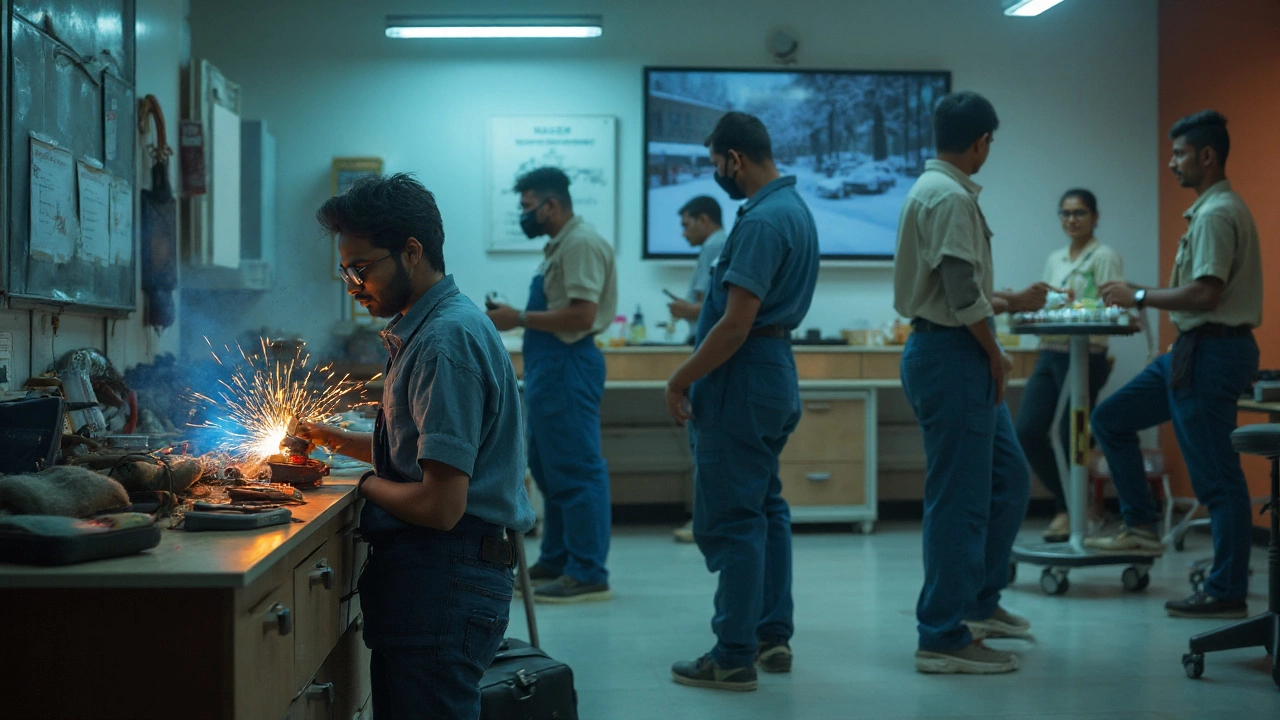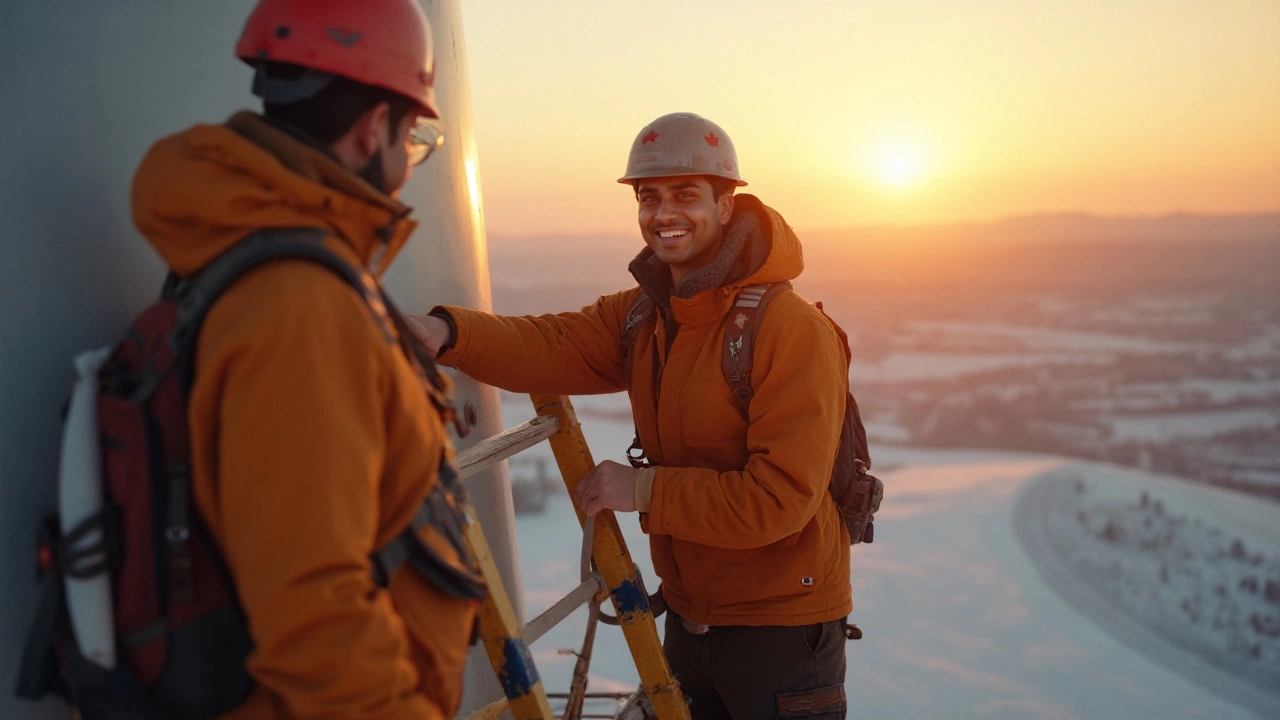Highest-Paid Vocational Jobs in 2025: Top Trades, Salaries, and Training Paths
 Sep, 19 2025
Sep, 19 2025
You clicked this because you want one thing: the highest-paid vocational job you can actually land-fast, without a four-year degree. Short answer? It depends on your country, your tolerance for stress or heights, and whether you want healthcare shifts or a unionized toolbox. Expect a handful of roles to dominate the top of the pay chart: Air Traffic Controllers, Commercial Pilots (non-airline), Elevator Mechanics, Radiation Therapists, and Power-Line or Power System Electricians. The trick is matching your strengths with a license or apprenticeship that employers value in 2025.
- highest paid vocational jobs typically include Air Traffic Controllers (US), Commercial Pilots, Elevator Installers/Repairers, Radiation Therapists, and Power-Line/Power System Electricians.
- US snapshot (2025 hiring reality): Air Traffic Controllers and Commercial Pilots lead six-figure medians; Elevator Mechanics and Radiation Therapists sit near/above the $90k line, often more with overtime.
- Canada snapshot (2025): Commercial Pilots, Elevator Mechanics, Power System Electricians, Dental Hygienists, and Radiation Therapists post strong six-figure potential with OT and premiums.
- Fastest path to high pay: Unionized apprenticeships (elevator, electrical) or regulated licenses (CPL for pilots, NAV CANADA for controllers, ARRT/CMRT for imaging/therapies).
- Best rule of thumb: Regulated + risky/complex + 24/7 infrastructure = top wages. If it stops, the city stops.
Quick answer: what pays the most without a four-year degree?
I’ll give you the top earners and the caveats. I live in Toronto, and when my son asks which trade makes the most, I tell him: pay follows regulation, safety risk, and round-the-clock infrastructure. That’s why controllers, pilots, elevator mechanics, and power trades keep showing up at the top.
United States (2025):
- Air Traffic Controller (ATC): Median pay around the mid-$130k range (BLS 2024 data releases trend in this band), with the top decile well into the high $100ks. No bachelor’s required; you need FAA-approved training, exams, and to pass a rigorous selection process.
- Commercial Pilot (non-airline): Median around $115k-$120k (BLS 2023-2024 trend), top decile surpassing $200k in certain sectors (corporate, charter, medevac with heavy hours).
- Elevator Installer/Repairer: Median near $100k (BLS reports ~101k in 2023), often $120k-$150k with overtime in big metros; union apprenticeships make the path predictable if competitive.
- Radiation Therapist: Upper-$80k to mid-$90k median (BLS 2023-2024), top decile ~$120k-$130k. Associate degree + national certification (ARRT) + state license where required.
- Electrical Power-Line Installer/Repairer: Low-$80k median with frequent OT; top decile crosses $120k. Storm work boosts earnings.
Canada (2025):
- Commercial Pilot (non-airline): Commonly $90k-$150k total comp depending on hours, region, and equipment; medevac and corporate roles pay more; northern rotations add premiums.
- Elevator Constructor/Mechanic (Red Seal): $45-$60+ per hour in major provinces, often $100k-$140k+ with OT and shift premiums (Ontario and BC are hot markets).
- Power System Electrician / Industrial Electrician (Red Seal): $45-$60 per hour typical; project work and call-outs push annuals past $120k in utilities, transit, and energy.
- Radiation Therapist and MRI/Nuclear Medicine Technologist: $40-$55 per hour, with full-time comp ~$85k-$110k; night/weekend premiums raise it.
- Dental Hygienist: $45-$55 per hour in many cities; full-time equivalent can land near $90k-$110k, though it varies by clinic and province.
Sources you can trust: U.S. Bureau of Labor Statistics (Occupational Employment and Wage Statistics, latest May 2024 releases by occupation), FAA for ATC hiring and pay bands, Transport Canada for pilot licenses and medicals, NAV CANADA for controller recruitment, Government of Canada Job Bank for wage ranges by NOC, and provincial apprenticeship authorities for union rates.
So what’s “the” highest-paid vocational job? In the US, Air Traffic Controller is often the single top earner when you factor median pay and benefits, but it’s the hardest to enter. In Canada, Commercial Pilot and Elevator Mechanic are common six-figure winners depending on hours and overtime, with Power System Electricians not far behind.
| Role | US Median Pay (USD) | US Top 10% (USD) | Canada Typical Range (CAD) | Training Time | Typical Path |
|---|---|---|---|---|---|
| Air Traffic Controller | $130k-$140k | $180k-$200k+ | $125k-$180k | 12-36 months | FAA/NAV CANADA selection + academy + on-the-job |
| Commercial Pilot (non-airline) | $110k-$120k | $180k-$220k+ | $90k-$150k+ | 12-24 months | Flight school to CPL + ratings + hours |
| Elevator Installer/Repairer | ~$100k | $130k-$150k+ | $100k-$140k+ | 4-5 years | Union apprenticeship + Red Seal (CA) |
| Radiation Therapist | $90k-$95k | $120k-$130k | $85k-$110k | 2-3 years | Assoc. degree/diploma + ARRT/CMRT |
| Power-Line/Power System Electrician | $80k-$90k | $120k+ | $95k-$130k+ | 4 years (appr.) | Apprenticeship + license/Red Seal |
| Dental Hygienist | $80k-$90k | $110k+ | $90k-$110k | 2-3 years | Accredited program + provincial/state license |
| Aircraft Mechanic (A&P / AME) | $72k-$78k | $100k-$110k+ | $75k-$105k | 2-4 years | A&P/AME program + hours + exams |
| Wind Turbine Technician | $55k-$65k | $85k-$95k | $65k-$95k | 6-24 months | Technical diploma + safety certs + travel |
Notes: Wage bands reflect 2023-2025 ranges from BLS (US) and Job Bank/union postings (Canada). Overtime, shift premiums, call-outs, and travel can materially increase annual earnings, especially in elevator, power, aviation, and wind tech roles.

How to pick your path and get qualified (without wasting time or money)
What are you really trying to do here? Most readers I talk to want to: 1) find the single best-paying option they can qualify for, 2) know the training time and cost, 3) see the odds of actually getting hired, 4) understand day-to-day reality, and 5) avoid dead ends. Here’s a tight framework that works.
Rule of 3 for high pay: If a job is regulated, safety-critical, and runs on 24/7 infrastructure (airports, hospitals, power grids, transit, elevators), it usually pays top tier. That’s why you keep seeing ATC, pilots, elevator, power, and medical imaging/therapy.
5-step decision path:
- Screen for disqualifiers in minutes. Bad color vision? ATC and some imaging roles may be out. Motion sickness? Reconsider flight. Can’t handle heights? Line work and wind tech will be rough. Medical history? Check Transport Canada/FAA medical categories before you spend a dollar.
- Pick the credential that employers must respect. Examples: FAA/NAV CANADA controller ratings, CPL with instrument/multi-engine, IUEC elevator apprenticeship, Red Seal (Canada), ARRT for radiation therapy. If a license is required, wages are defensible.
- Map training time vs. payback window. Use this simple math: Payback (months) = Total training cost / (Expected net monthly pay increase). Net pay increase = New monthly pay - Current monthly pay. If you’re making $3,000/month now and can get to $7,500/month in 24 months, every $30k in tuition pays back in ~7.5 months after you start the new job.
- Check local demand, not just national averages. In Toronto and the GTA, elevator and power trades are buoyed by constant construction and transit projects. In US Gulf states, industrial electricians and instrument techs command premiums. Look at union bid books, Job Bank projections, and BLS occupational outlook, then filter by your city.
- Pressure-test day-in-the-life. Shadow someone, tour a training center, or take an intro discovery class. A perfect salary that doesn’t match your temperament is a trap. ATC stress is real. Night shifts in hospitals are real. So are heights on a windy nacelle in January.
Training costs and realistic timelines (ballpark):
- ATC: Application is free; paid training once accepted. The real cost is the selection hurdle and relocation flexibility. Expect 12-36 months from application to certification if all goes smoothly.
- Commercial Pilot: $60k-$100k+ for CPL, instrument, multi, and hours to meet hiring mins. 12-24 months if full-time. Scholarships exist; some employers help with time-building.
- Elevator Mechanic: Apprenticeship wages while you learn; tools/dues/training fees are manageable. 4-5 years to journeyperson, but you’re paid the whole way and rises are scheduled.
- Radiation Therapist: 2-3 years in an accredited program. Tuition varies widely. Practicums are competitive; plan early.
- Power-Line/Power System Electrician: 4-year apprenticeship with progressive wage steps. Expect seasonal OT spikes.
Fast filters by personality and tolerance:
- Hate heights, love radios and systems? ATC.
- Love precision tools and can handle grime? Elevator or aircraft mechanic.
- Want patient care with tech, steady climate-controlled work? Radiation therapy or imaging tech.
- Comfortable with travel, odd hours, and responsibility? Commercial pilot.
- Weather-proof, physically strong, okay with storms? Power-line.
Pro tip: Union + license is the pay combo you want. It hardens the floor on wages and makes raises predictable. If you’re in Ontario like me, watch for IUEC (elevator), IBEW (electrical), UA (pipe trades), and speak directly to training coordinators-slots fill quickly.
Common pitfalls to avoid:
- Buying a course before checking hiring standards (medical, background, vision, language). Fix your gate checks first.
- Chasing headline salaries without overtime or location context. A $100k “average” that requires 20 hours of OT a week is not the same lifestyle as a $100k base.
- Underestimating math and physics content. ATC, pilot, and many tech roles demand solid numeracy. If you’re rusty, take a prep course first; it speeds everything up.

Examples, tables, checklists, and FAQs (Canada + US)
Let’s go concrete. Below are real-world pathways, quick examples, and a pocket checklist you can use this week.
Example 1: Fastest route to six figures with the highest odds
Elevator Mechanic via union apprenticeship. Why? You earn while you learn, don’t need to bankroll a two-year tuition gap, and the work is tied to essential infrastructure. In Toronto and most US metros, demand has been steady, and journeyperson wages plus OT can clear $120k. The trade-off: the apprenticeship intake is competitive. Nail the aptitude test (mechanical reasoning, math), keep your record clean, and be open to early-morning calls.
Example 2: Highest single salary ceiling
Air Traffic Controller in the US or Canada. The base pay beats most trades, and benefits are strong. The trade-off: strict selection, intense training, and a job that demands calm under pressure. If you thrive on puzzles and can stay sharp in busy environments, this is a contender.
Example 3: Healthcare path with strong pay, stable hours
Radiation Therapist. The work is meaningful, the tech is advanced, and the hourly rate is solid. The trade-off: competitive program admissions and clinical placements. Call local hospitals and program coordinators now-ask what makes a standout applicant in 2025.
Example 4: High autonomy, travel, and peak pay with hustle
Commercial Pilot. Your earnings grow with hours and equipment. The trade-off: upfront cost and a few years of building time. People underestimate the pace here: if you treat it like a full-time job, you can stack ratings and move quickly. Many pilots I know created a strict schedule-sim practice, ground school blocks, flight windows-and shaved months off the timeline.
ROI cheat sheet
- Elevator apprenticeship ROI: Immediate partial wages + step increases. Net positive from month one. Payback is essentially the time to journeyperson.
- Pilot ROI: Highest risk/reward. Use employer tuition assistance where possible, and line up weekend contract gigs (survey, banner tow) to offset hours costs.
- ATC ROI: No tuition; the real “cost” is the selection funnel. Apply early and widely; relocation flexibility increases odds.
- Healthcare tech ROI: Tuitional but predictable. Scholarships + hospital sponsorships help; many programs have excellent placement rates.
Quick credentials map (what employers ask for):
- ATC (US): Meet FAA AT-SA test standards, medical, security; pass academy; on-the-job training at facility. (Canada: NAV CANADA aptitude, training, and on-site certification.)
- Commercial Pilot: Transport Canada/FAA medical, CPL, instrument rating; multi-engine strongly preferred. Build hours via instruction, survey, regional ops.
- Elevator Mechanic: IUEC (US/Canada) apprenticeship acceptance, classroom hours, on-the-job hours, provincial Red Seal exam (Canada).
- Radiation Therapist: Accredited program, ARRT (US) or CAMRT/CMRT (Canada), state/provincial registration.
- Power-Line/Power System Electrician: Apprenticeship sign-on, safety tickets (e.g., WHMIS, working at heights), Red Seal exam (Canada) or state license (US).
Checklist: Are you a good match for top-paying vocational roles?
- Vision, hearing, medical cleared for your target role.
- Comfort with either stress (ATC/pilot), heights/weather (line/wind), or patients/precision (therapy/imaging).
- Willing to work shifts, nights, or on-call for premiums.
- Basic algebra/geometry comfort; mechanical reasoning.
- Clean record (background checks matter in airports, hospitals, utilities).
- Willing to relocate for training or first job if needed.
How to apply smart (US and Canada):
- Controllers: Monitor FAA USAJOBS or NAV CANADA careers, set alerts, and prepare for aptitude tests. Join online study groups-scores matter.
- Pilots: Shortlist 3-5 flight schools with strong placement. Ask for cost-per-hour on the exact aircraft, wait times for instructors, and job placement stats.
- Elevator: Watch IUEC/Local postings. Practice mechanical reasoning tests. Start as a helper to learn the ropes if intakes are closed.
- Healthcare tech: Contact program coordinators, ask for last year’s admission GPA range, entrance test formats, and clinical site availability.
- Power trades: Apply to multiple employers and the union simultaneously. Storm season is hiring season-be ready.
Mini-FAQ
- Is “vocational” the same as “trade”? Close enough for most decisions. I’m using it to mean high-skill jobs that don’t require a four-year degree, including apprenticeships and associate-level healthcare/aviation roles.
- Which pays more: electrician or plumber? Electricians in power systems typically edge out plumbers on median, but union plumbers can match or beat them with OT in industrial jobs.
- What’s the fastest path to $100k? Elevator apprenticeship in a big city, or line work with steady OT. For non-tools roles, ATC if you clear the selection quickly.
- Do women do well in these? Yes. Unions and healthcare pathways in particular have strong support and mentorship networks. Wages are set by contract or scale.
- How risky are these jobs? Each has different risks-ATC stress, flight safety, electrical hazards, heights. Training focuses on risk control. Pick the risk you can manage well.
Next steps
- If you’re in Canada and want six figures fast with low tuition risk: call your local elevator union hall or training center, ask about the next intake, and start prepping for the aptitude test this week.
- If you’re in the US and want the absolute highest median: open an FAA USAJOBS account, set alerts for ATC openings, download an AT-SA study guide, and block out daily practice time.
- If healthcare appeals to you: shortlist two accredited radiation therapy programs and book an info session. Ask about clinical site capacity before you apply.
- If aviation is your thing: tour two flight schools, request a written cost breakdown to CPL with instrument and multi, and speak to two recent grads about their first jobs.
Troubleshooting by persona
- Mid-career parent with limited savings: favor paid apprenticeships (elevator, electrical). You’ll earn while training and avoid big tuition debt.
- Recent grad who excels at tests: consider ATC. Your study stamina gives you an edge in the selection process.
- Mechanically gifted, hates classrooms: go elevator or aircraft maintenance. Learning is hands-on, and your skill shows in the field.
- People-first, science-curious: radiation therapy or imaging. Strong pay, structured career ladders, predictable shifts.
- Adventurous, self-directed: pilot. Costly upfront, but freedom and long-run pay can be excellent if you’re disciplined.
One last sanity check: salaries move, but the pattern doesn’t. If the job is licensed, safety-critical, and keeps cities running, pay follows. That’s where you should look first-and where I point my own kid when he asks what to aim for in a world that still needs skilled hands and clear heads.